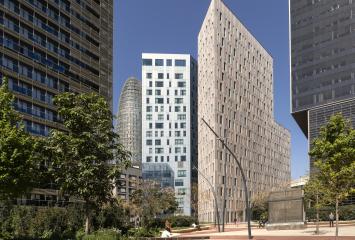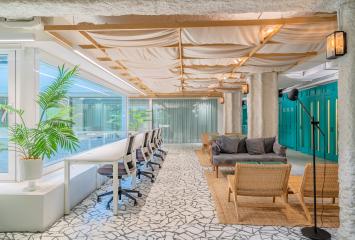Vertical gardens, waterfalls, trees and flowers: a wild office
The idea of incorporating natural elements into offices stems from the scientific hypothesis known as biophilia, which suggests that humans have an innate connection with nature, making them feel happier in green environments. And not just that: as proven by this research from the School of Psychology at Cardiff University, the presence of plants in the office also boosts productivity by improving both concentration and creativity. For this reason, many architects and designers are going a step further by incorporating real green structures into these spaces. Welcome to the wild office.
Key elements for a wild office
Transitioning from a subtly biophilic office, with a few scattered plants, to a deeply biophilic one, requires the installation of prominent green elements. One example is vertical gardens. In addition to saving usable space compared to traditional gardens, they have a much more significant visual impact, surrounding workers and clients in the workspace with an aura of beauty, freshness, and life, putting them in a more positive mindset. This structure also allows for the play of colors and shapes to create symbolic murals that convey brand information.
Another example is trees and flowers. Generally, office greenery tends to be limited to plants, but trees and flowers are more vibrant and awaken people's biophilic instincts more intensely. In this sense, adding trees that provide shade outside the building and colorful flowers to brighten the space is a fantastic strategy to make workers feel more comfortable in the workplace. Environments that are overly urban can negatively impact mood. These small but powerful details can make a huge difference.
But the wild office doesn’t rely solely on greenery. Another key element, water, has a unique ability to trigger a sense of connection with nature, and we should take advantage of it. Fountains, and especially waterfalls, which are much more spectacular, are key elements in this regard, creating mental peace both visually and audibly. Finally, it's worth highlighting the role of the wild in improving air quality in the office and controlling humidity levels. It’s not just a matter of psychological well-being, but also physical. However, despite all these benefits, certain considerations need to be taken into account.
Not just any way
The wild office will be the office of the future — or at least one of its most widespread variations. However, biophilia, the impact of nature on people, should never conflict with another important goal: sustainability and environmental protection. That’s why the incorporation of wild green elements such as vertical gardens, green roofs, or trees must be done following a set of ethical guidelines: efficient automated irrigation systems, the use of recycled water whenever possible, choosing native trees and flowers, and plant rotation. Because wild was never meant to be synonymous with harmful.

